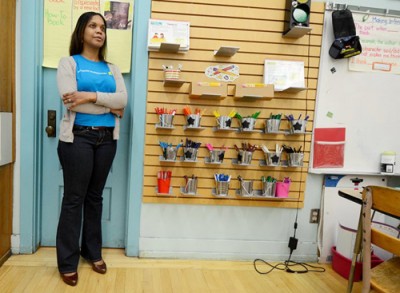Long-neglected law on teacher evaluations rises to forefront
LOS ANGELES – The road to an agreement on teacher evaluations has been a long and costly one that is not yet finished. But recent litigation has put the Los Angeles Unified School District on a fast track.
The spotlight on teacher evaluations widened last June when Los Angeles County Superior Court Judge James Chalfant ruled that the district was violating California’s longstanding teacher evaluation law, the Stull Act, by not ensuring test scores were used.
The 1971 law, signed by then-Gov. Ronald Reagan and named after a former Republican lawmaker, requires student achievement to be included in teacher evaluations – something Los Angeles Unified, and most districts, resisted for decades. Some districts found they didn’t need to fully comply with the Stull Act to receive millions of dollars from the state designated for linking teacher evaluations to student achievement.
The spotlight on teacher evaluations widened last June when Los Angeles County Superior Court Judge James Chalfant ruled that the district was violating California’s longstanding teacher evaluation law, the Stull Act, by not ensuring test scores were used.
The 1971 law, signed by then-Gov. Ronald Reagan and named after a former Republican lawmaker, requires student achievement to be included in teacher evaluations – something Los Angeles Unified, and most districts, resisted for decades. Some districts found they didn’t need to fully comply with the Stull Act to receive millions of dollars from the state designated for linking teacher evaluations to student achievement.
Melrose Elementary teachers and its principal, Bernadette Lucas, took part in Los Angeles Unified School District’s pilot teacher evaluation program, which factored in student achievement to determine teacher effectiveness.
Credit: Carlos A. Moreno / The Center for Investigative Reporting
The law was amended in 1999 under Gov. Gray Davis, requiring school boards to evaluate teachers based on state test scores as they “reasonably relate” to a teacher’s classroom performance, a vague term that effectivelyCredit: Carlos A. Moreno / The Center for Investigative Reporting
As state watches, LA Unified tests new ways to grade teachers
LOS ANGELES – Robin Wynne Davis was taken aback last year when the state test score gains of her third-grade students at Melrose Elementary School labeled her a less-than-stellar teacher.
“I am just an average teacher, according to that data, but if you look at my class and see how many children are proficient and advanced, it’s a lot of kids,” said Wynne Davis, now an instructional support coach for Melrose Elementary in central Los Angeles.
Seeing her assessment as an “average” teacher in English and a “more effective than average” teacher in math hit the Los Angeles Times a few years ago was upsetting and embarrassing, she said. The assessment of her
“I am just an average teacher, according to that data, but if you look at my class and see how many children are proficient and advanced, it’s a lot of kids,” said Wynne Davis, now an instructional support coach for Melrose Elementary in central Los Angeles.
Seeing her assessment as an “average” teacher in English and a “more effective than average” teacher in math hit the Los Angeles Times a few years ago was upsetting and embarrassing, she said. The assessment of her
Data support disruption theory as online, blended learning grow
When Disrupting Class hit the bookstores five years ago, it contained a prediction that stunned many: by 2019, we said, 50 percent of all high school courses would be delivered online in some form or fashion. The prediction was built off of data from third-party sources that had been collected over the previous eight years on the number of students taking online courses. At the time, calculations using that data also indicated that the majority of the online learning would occur in blended-learning environments.
Since then, as online and blended learning have grown in K–12 education, it’s been difficult to know how that prediction has held up because there has been a paucity of good, trustworthy data.
The California Learning Resource Network (CLRN) has stood out, however, as one group trying to fill the data gap about what’s happening in California’s schools—and it’s done its work in a nuanced way that gives a reasonably
Since then, as online and blended learning have grown in K–12 education, it’s been difficult to know how that prediction has held up because there has been a paucity of good, trustworthy data.
The California Learning Resource Network (CLRN) has stood out, however, as one group trying to fill the data gap about what’s happening in California’s schools—and it’s done its work in a nuanced way that gives a reasonably

